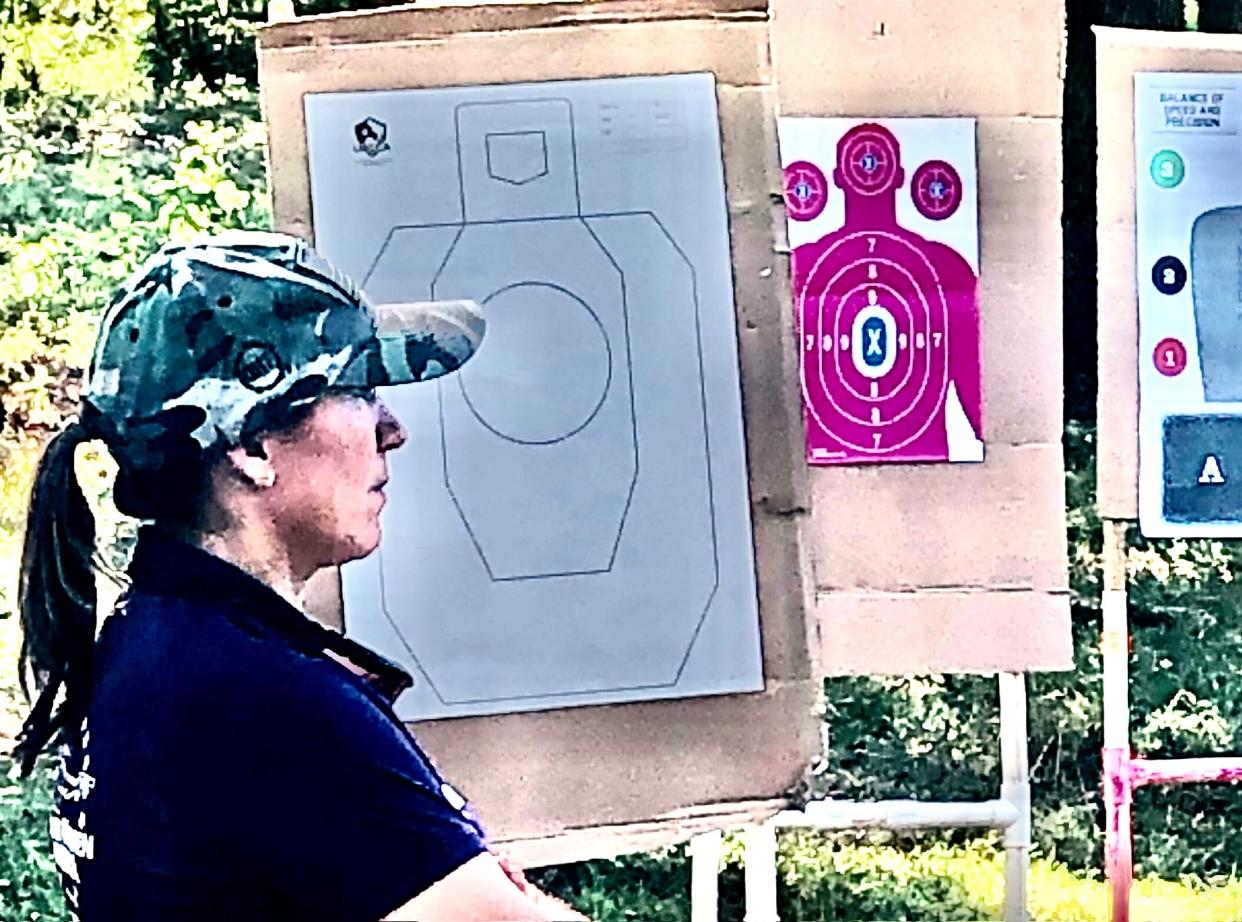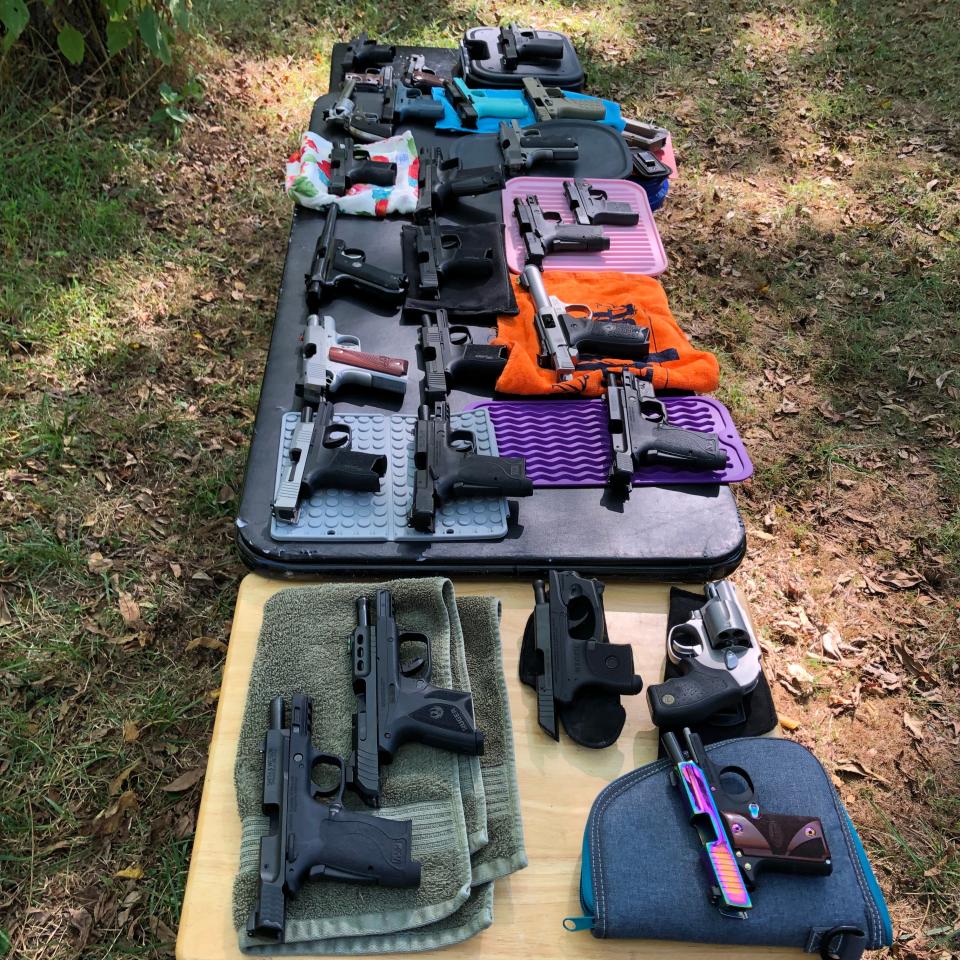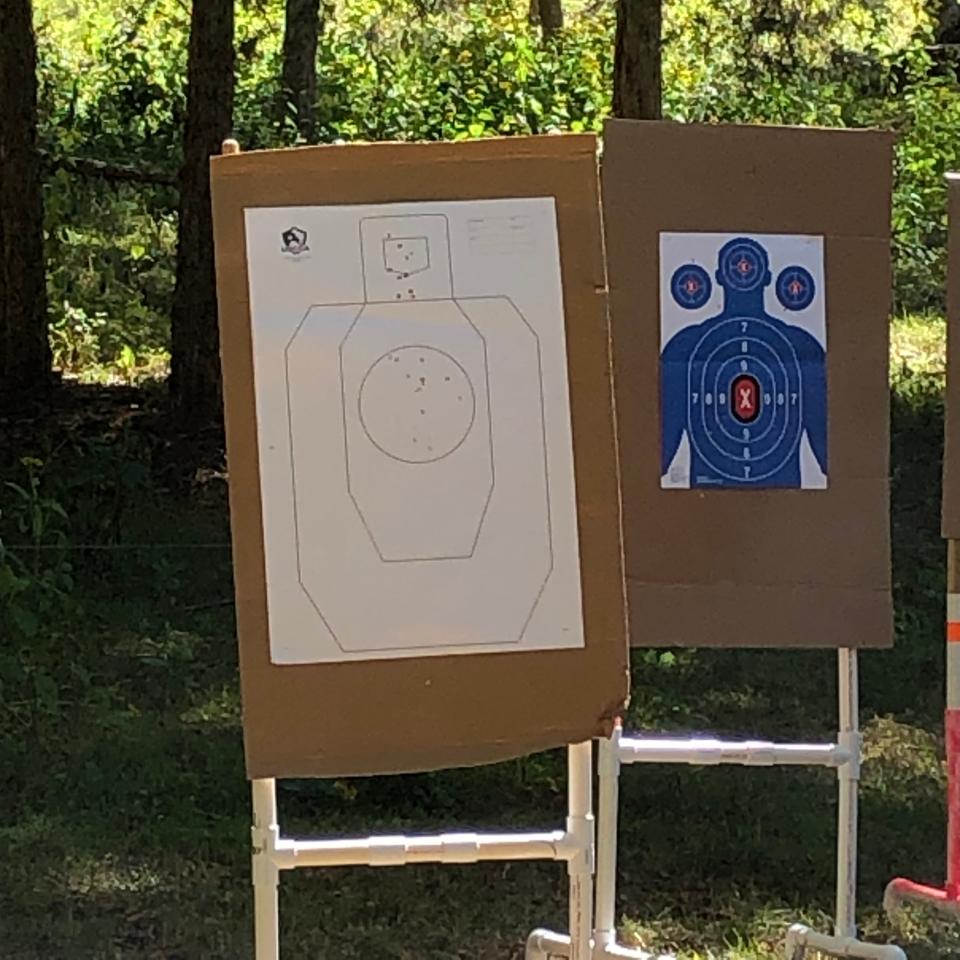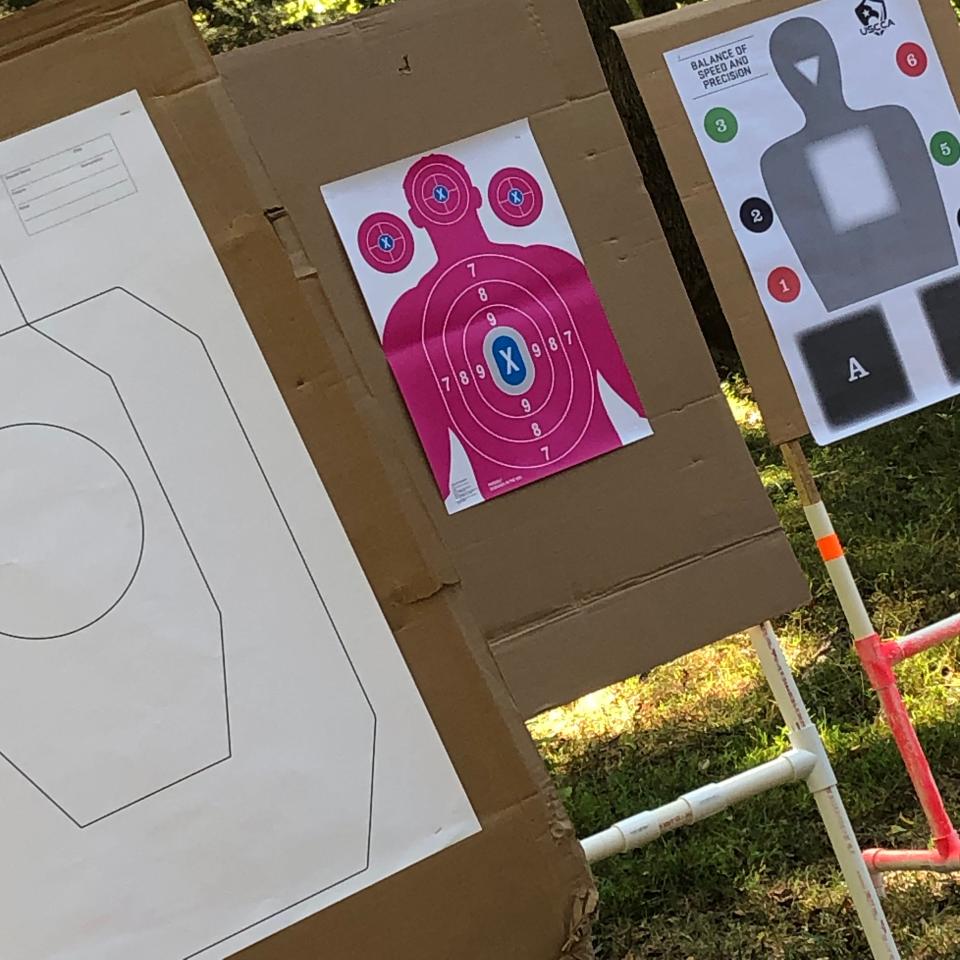Women carry guns for lots of reasons, but mostly one. Men.

The woman posted the flyer at Gypsy Hill Park bulletin board inviting women to gather at a monthly meeting. It was torn down a few days later. She printed out another copy and returned to the park’s bulletin board. Days later it was torn down.
This happened a dozen times. Each time the woman saw the sign had been removed, she went home and printed out the flyer again, and put it up again.
One day she returned to the park to find the poster was still there.
It had been torn to pieces. The pieces lay on the ground near the trash can.
She brought home the torn-up sign and took a photograph and wrote about it on Facebook. Eventually she received permission from Staunton Parks and Recreation to put her flyer in a locked cabinet with a glass door.
The sign stayed.
*
You’ve probably never seen so many handguns sitting on a card table outside like this. You’re in the middle of late summer farmland, in a hollow surrounded by harvested fields, except for this grove of trees raining dappled sunlight into the clearing where about two dozen women have gathered.

Smith & Wesson EZ380, Sig Sauer P365, Ruger LCR. Glock. You don’t know where you are, really, just that it’s an undisclosed location that a private landowner lends on certain Saturdays for use by this group of women. You met them in a church parking lot and then followed the caravan of cars up and down country roads until the road narrows into a private driveway and the driveway sloughs into grass and the grass stops at a farm gate.
One by one the women exit their cars and stand in small groups, and after introductions they begin presenting their handguns to the group’s leaders and placing those guns on the long card table, which rapidly fills and spills over onto a second table.
The guns all point in the same direction: away from people. Even though they’ve been checked and are unloaded. It’s probably not something you’re used to seeing outside of gun shows.
Unless you’re a woman.
The Armed Women of America’s Augusta County branch, co-founded by Andrea Barkley and Christy Knopp, has led training and target practices since 2021. In 2022 they started C-BAR Firearms Training, where they teach concealed carry certification classes, as well as proper shooting technique. In their office is one smallish room where they use laser pistols to learn proper grip and aiming for accuracy. Laser beams point across the room to land crisply on targets with squares starting around their collarbones. No bullseyes here: you hit anywhere in that square and it will help disable a threat.
"We have a lot of brand new gun and pistol owners" come in for training, Andrea says. "We do get a lot of people in here that have experience with their rifles. And shotguns. But handguns are new to a lot of a lot of people, which may may or may not surprise you."
And every handgun is a little different, with unique grip, size and kickback when it's actually fired. Which is why live-fire training with your gun and ammunition is so important.
The women here today for the monthly AWA meeting are in their 20s; they’re in their early 80s; they’re every age between. They grew up with guns; they never saw a firearm until they were out on their own. They’re widows and nearly newlyweds and single moms and just plain single. They don’t judge each other’s politics, but they all check out each other’s shooting technique.
“It’s the Reverend Doctor Patricia Meadows,” someone intones formally as the woman raises her hand when asked for a show of hands about who has certain first aid and nursing knowledge. Though there’s laughter, it’s another sign of what is clearly an insistence on planning and safety before anyone loads their gun.
They come prepared. Besides their gun and ammunition, the two most important pieces of gear are a folding chair and proper ear protection.
It gets loud when half a dozen people are shooting at the same time.
Laurie Douglas of Laurie’s Chocolates makes small talk, hands out sample treats and talks ammo.
But mostly they talk about safety. Even when everyone puts on their ear protection and the shooting starts.
*
She was running along the shoreline when Michele Powers was grabbed roughly by a man on the beach. He was a “leftover drunk” from one of last night’s parties, she figured, and she was young and strong. She pushed him away and he flopped to the sand. She took a second to curse him out and continued running.
It’s one of the two times when she felt threatened enough by a man to consider whether she would have acted differently if she’d been carrying a gun. In this case, looking back she didn’t think she’d have done anything differently. She felt confident in her own strength, and speed, to separate herself from an attacker and put distance between them.
The second time was scarier.
She was still young and strong and quick, but she was a mother now, and in a house alone with her two children. And at kicking at her door, yelling for her to open it, stood the previous tenant’s abusive ex, somehow convinced that Michele was giving shelter to the woman he wanted to take back. She’d called 911 but the police were slow to respond.
At that point in her life, Michele had one tool of self-defense: her son’s baseball bat.
Later, she'd add a cattle prod to her defensive arsenal. If the man managed to break glass and put a hand inside to turn the knob, he’d get a healthy blast from the cattle prod. If he kept coming, there was the baseball bat. She had never been so frightened, guarding her children and fearing for all their lives.
Thinking back, if she’d had a gun then, she would have let him know she had it, and yes, she would have used it if she needed to. Now, decades later, having moved to Staunton and living with her spouse, she is a handgun owner, with a concealed carry permit, and she regularly practices her shooting. She might be considered more liberal than your average handgun owner, but maybe that’s already a mythical average. Why does she have a gun? Her answer has no politics in it. “I’m not as strong and quick as I used to be,” she explains simply.
*
Andrea and Christy talk about the safety procedures. Again. “We never apologize for talking about safety,” each of them says a few times during the morning. Their fellow Armed Women of America members, some wearing purple t-shirts, smile knowingly.
They have a first aid kit. They have a trauma kit. They have a pickup truck backed into the clearing with its bed door open. Three of the women are nurses and 6 people raise their hands when asked if they are trained in how to apply a tourniquet.
Christy takes the crowd of a few dozen women through the rudimentary steps of applying one. “And you twist it like a faucet,” she finishes.
Most of the roughly two dozen women have been here before. That number is close to half of the consistent membership of AWA over the last few years. Andrea says it’s one of the highest percentages of attendance at shooting practice in any AWA branch.
“You do not want to step across the firing line,” Christy Knopp instructs the group. Behind her and that line of string in the grass are propped six man-sized targets, at various distances from the line.
Behind them the land slopes up among tall trees. Birdsong runs like a current through the canopy. Even after the shooting begins, whenever there’s a pause you can still hear the birdsong. They must be used to it.
When the first shooter picks up her gun, steps to the line and loads it, drops into a stabilizing stance and takes her shot with an oversized revolver, the bullet will pass through the chest of the first target. A puff of dirt will rise twenty or thirty feet behind the target where bullet finally meets something solid enough to stop it.
*
People buy handguns mostly for self-defense. To protect themselves and their family. But the presence of guns in a house raises the chance that someone in that house will be the victim of gun violence.
Recently, a 19-year-old from Hopewell, Va. was showing his brother his new handgun, and the gun went off, a bullet punching through the wall of his bedroom and the bedpost in the next room and killing his mother Dawn, who was sitting on her bed talking to her boyfriend.
The young man had purchased a handgun to protect the family after a rash of shootings in his neighborhood.
That’s why it’s still all about safety an hour into the morning, where everyone has moved from the left side of the targets to the right, placing their empty guns on a table on the far side, where soon they’ll pick them up and begin again.
“This is your work space here.” Christy holds her hand to her hip holster. “You always keep that muzzle down-range.”

They walk through birdsong, sunlight and laughter back to the table, pick up their gun and step to the line, load their weapon, and once again face the first target.
“Don’t cross your thumbs,” Christy advises one of the women.
“Watch your slide back,” says Andrea.
The second round ends and women are munching on chocolate, drinking water, and talking about an app that measures your accuracy at shooting.
“Who else has a Sig 365?” Andrea asks, standing at the table and looking at a gun. That gun was presented and placed at the table but hasn’t been used for target practice yet.
“Me,” a woman calls out. “Mine has the silver top.”
Nancy Barkley’s been shooting for two years. She’s 81. She favors her Smith & Wesson 380. She also trains on indoor shooting ranges in Roanoke and Lynchburg. “It’s always fun just to get out and shoot.”
One round of shooting blurs into another.

“My hands are a little shaky,” another of the older women says. And they are. They visibly quiver as she holds them up to Andrea. Until she loads one of the largest revolvers on the table, squares her feet and drops into shooting stance. One, two, three bullets whizz through the target’s chest and one, two, three puffs of red dirt fly up on the hillside thirty feet away.
They’re not carrying their weapons as a form of conspicuous consumption. Some are living alone. Some are the parents of small children. Some have concealed carry permits, and some of them carry all the time. Some carry their guns in their vehicles. Some store them in a locked box at night and some leave their gun within arm’s reach in a special holster that hangs between the mattress and box spring of their bed.
They may have various reasons for owning firearms. Some own several, including rifles and AR-style weapons. But in this group it’s all about handguns; all about self-defense, shooting at human targets at distances from 9 to 15 feet. They have guns to protect themselves, against men. And it’s human-shaped targets they are shooting at.
*
Andrea Barkley and Christy Knopp stress that not all their targets look like men. They want you to understand that anybody can be a threat when you are assessing danger around them. They do admit that men are far more likely to assault women than women are to assault anyone.
Guns magnify that threat; it’s why Virginia has a law on the books that says a person with a protective order taken out against them must surrender their firearms within 24 hours to law enforcement. It’s also a felony to purchase or lend a gun to someone whose activities are limited by a protective order. The numbers are overwhelmingly male offenders.
In their office on Churchville Ave, there are several small rooms. One holds nearly 20 chairs in a classroom set up for their concealed carry certification teaching. Safety posters hang on every wall. Another has the laser pistols and targets.
Although gun control and gun ownership are political issues to most people, gun safety has no politics. It has training, technique, muscle memory from practicing and thinking about scenarios before they happen to you. That’s what Andrea and Christy teach.
It’s about learning safety, learning technique. It’s about maintaining skill level.
You don’t change into a new human being just because you have a gun, they say. Media stories about men with guns being like first responders and “running towards danger” is not what gun ownership is about.
*
Michele Powers and her partner have a plan should someone break into their house. And it’s not to charge toward danger with a gun. It’s about staying alive, protecting themselves, and getting out.
A gun shouldn’t make you feel braver, says Andrea.
Only a few weeks back, Christy was strapping her youngest child into her car to get her to school. The morning was still dark. Christy was adding radiator fluid to the car when she heard screaming, and then cries for help. She has a concealed carry permit, and she was carrying her gun at the time. She reached into her pocket and pulled out her phone. She called 911, then unbuckled her child and brought her back into their house to wait for police to arrive.
“But mommy, you have a gun,” her daughter said.
She explained to her daughter that having a gun doesn’t change who you are or what is the right thing to do. “It was a learning moment for her, I think,” Christy said.
Andrea and Christy are not anti-regulation activists. They both teach a certification program required for a permit to carry a concealed firearm, after all. They contribute where they think they can do the most positive work, training people to be safe and to safely defend themselves, not to go look for trouble. Men and women take their classes at C-BAR; they're not a women-only business. They might say they're a safety-only business.
Michele Powers doesn’t feel changed by her guns. She has been disturbed by the tragic shootings that seem to sweep over the country like a plague. What if, in a magical world, all those shootings would never happen if you just gave up your guns? Would you do it?
Most women who own guns do not partake of such magical thinking. It's hard enough just to make sense of a world where people tear down signs inviting women to connect with each other while they learn to sharpen their skills and protect themselves.
But neither do they live in a world where they deny the danger of guns in the hands of dangerous people. When pressed, Michele mused that if it were that easy, if all the school shootings could be avoided if she gave up her guns, she just might, she said, go back to the old cattle prod.
In the real world, where she’s not as strong, not as quick, in a world that seems to spin us around each day faster and more chaotically, she’s comfortable with her decision to be an armed woman.
This article originally appeared on Staunton News Leader: Virginia armed women group makes safety, accuracy, preparation priorities

